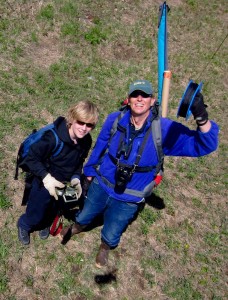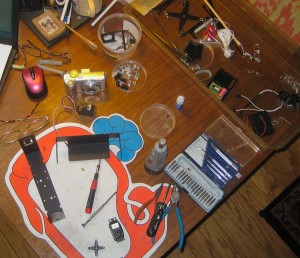The Lytro camera is probably the most interesting advance in photographic technology this year. An array of microlenses allows the sensor to capture information about the exact direction from which light is coming, and that allows software to focus every part of the scene regardless of it’s distance from the camera. To highlight this advance, the company’s first camera produced interactive online images which could be refocused by clicking anywhere in the scene (see some here). We have all looked at photos with out-of-focus parts, and it is a novel experience to be able to click on or touch the fuzzy places and have the crisp focus shift as if a focusing ring was being turned. But it has also been maddening to know that the captured data would allow the entire photo to be in focus all at the same time, yet this was not an option for any Lytro photo. It was a clever marketing approach, because modern digital cameras with tiny sensors have very good depth of field, and many of the photos we take now already have everything in focus. Allowing the viewer to “focus the photo after it was taken” highlighted how new this technology was. Continue reading “Lytro Schmytro”
Tag: Technology
Design, Build, Turn
I think it is time to upgrade the technology I have used for 14 years to monitor the temperature of my compost pile.
The graph below is live, as long as I keep going out and reading the temperature and coming back in and updating the Google spreadsheet. In 1998 I inherited the old YSI thermometer device and found a 7.5 volt mercury battery for it. The battery is still good, and I even have a spare (also 14 years old). I hope that the participants at LEAFFEST can help me find a replacement technology for the beast.
The featured pile was built on September 10 from a three month accumulation of kitchen, garden, and yard waste, some old hay mulch, freshly cut alfalfa, 100 chopped corn plants, a quart of organic fertilizer (5-3-4), and 20 gallons of spent tomatoes, cucumbers, peppers and cabbage. The pile was turned on October 7.
Sunrise Orchards

Test Flight
Ever since I backed the balloon mapping Kickstarter project, I have been thinking about what to do with the matched pair of visible and infra-red cameras I will receive next month. I’m intrigued by the idea of making NDVI images by combining information from the two cameras. NDVI maps of vegetation can reveal new ecological patterns, but I still have no idea what I might learn with this tool. I have also been thinking about how to deploy the cameras to take aerial photos. The level of my Kickstarter pledge entitles me to a kit with cameras and other things, but it is not yet clear what other things will be included. So when it was 50° a couple of weeks ago and tolerable to work in the garage, I started playing with a piece of one of the aluminum storm window frames that were thrown behind the shed. The goal was to make a cheap, lightweight, self-leveling rig to hold two cameras pointing in the same direction: down. Continue reading “Test Flight”
Built to fly
I awoke this morning to see that not a leaf on the hornbeam was fluttering, and my head fell back to the pillow in dismay. This was a sure sign that I had a new hobby. It was the KAPer’s lament: no wind. I had flown a camera on a kite for two days in a row, and the thought of a calm day was discouraging. But I had started a stitch of yesterday’s aerial panorama before I went to bed, so I got up two hours before Galen had to be at school to check on it.

I built my first KAP rig last week from one of Brooks Leffler’s kits. I have never built anything with servos and dip switches and carbon fiber legs, but I got to use my Dremel tool, so it felt safe. Brooks has designed an elegant system for suspending a camera so that it can point in any direction. The pointing and shutter release are done either at predetermined intervals (autoKAP), or by radio control from the ground. The kit I built had servo motors for both panning and tilting and electronics to automatically point in as many as 76 directions and take photos potentially covering a downward-looking half-spherical view. By replacing the tiny circuit board with a radio receiver, the motors and shutter could be controlled via a transmitter on the ground. It is based on the RC airplane/car/boat/helo standards, so compatible equipment is readily available.
.
The succession of precedence
Google has digitized the text of five million books. The old ones are in the public domain and you can read them online at http://books.google.com/. Most of the more recent ones are still protected by copyright law, but that law did not anticipate the ingenuity at Google. The individual words and phrases in all those books are now in a huge database that anyone can search. Maybe you can’t read every book online, but you can learn how book writers have used the language over the past two centuries at http://ngrams.googlelabs.com/. This allows a very new kind of literary research – answering questions without reading. Although it turns out that some reading is still required. Continue reading “The succession of precedence”
Fine Conference
The Fine International Conference on Gigapixel Imaging for Science is winding down and I am really looking forward to the cocktail reception when today’s poster session ends. There is also going to be a raffle for a Gigapan Epic Pro, so there is still much to look forward to.
It has been a real joy to meet lots of people who I knew only through their work online at gigapan.org, many others whose work I hope to know soon, and all the media people who might be incorporating gigapans into their work. It was tremendous fun to see dozens of members of the gigapan community whom I met 18 months ago at my first Fine Outreach for Science Workshop. I have really enjoyed interacting with many people who are more obsessed with gigapixel imaging than I am.
The proceedings papers are now online at http://gigapixelscience.gigapan.org/. A higher resolution PDF of my paper is here. All the presentations were videotaped, so maybe they will be online at some point so I can see the concurrent talks I missed. [UPDATE: Video of my presentation at YouTube.]
The Prezis for my conference talk and the one for my Fine Outreach for Science talk are available online at Prezi.com. These are somewhat sparse in the sense that they are not very self-explanatory, but you might glean something from them if you attended my talks. Here is the motion bubble chart of my gigapan history that I used in the FOFS Workshop. And here is the kml file of Miss Pixie so you can see the Google Earth verification of the map I made of her locations. Here is a pioneering paper by Adam Dick et al. about mapping trees from 360° panoramas.
Thanks to the GigaPan teams for the tremendous effort they put into this event. It was a huge success.
